|
February 23, 2006
Brazilian Adventures: Expedition Cruising
on the Amazon and a Tall Ship Experience off the Coast of Rio
I am sucker for travel pictures and travel stories. And Latin America
is one of the places I have always wanted to go, and have never
been. So I decided to come out to a presentation about Brazilian
Adventures at Toronto's
G.A.P Store in the Annex neighbourhood.
Sean Benner and Jeff Russill both work for G.A.P
Adventures and have literally travelled the world, independently
and in small group adventure trips. Tonight they showed pictures
of some of their recent Brazil trips.
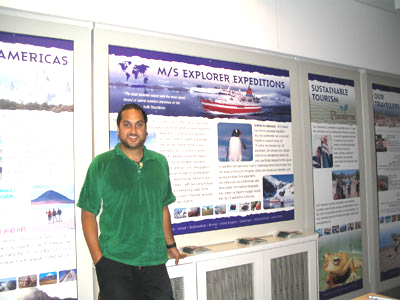
Sean Benner starts off the Amazon presentation
Before we even got started, a little surprise was waiting for us:
the crew at the G.A.P Store wanted to give us a really authentic
start to this Brazilian adventure, and they served us some authentic
Brazilian caipirinhas, a mixed drink consisting of Cachaça
(a Brazilian liquor made from sugarcane), sugar and lime. The mood
was now set for an authentic travel experience.
Sean, a former Latin American tour leader for G.A.P and a Brazil
specialist, told us the story of his 15-day trip called the "Wonders
of Brazil" exploration. The 15-day trip starts and ends
in Rio de Janeiro. Rio is an interesting metropolis, it is a narrow
city that stretches far up and down the Atlantic coastline and sprawls
up into the coastal mountains where most of the favelas (Rio's shantytowns)
are located. You can actually tour these areas with experienced
tour companies, but it is highly recommended that you not ever venture
into the favelas on your own.
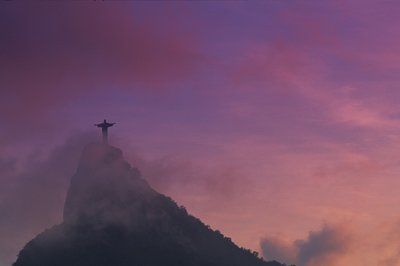
Christ the Redeemer blesses Rio
Rio de Janeiro is one of the most fascinating
cities in the world, and while there a trip up to Sugarloaf Mountain
to see the famous Christ the Redeemer Statue on Corcovado Mountain
is a must. Throw in the gorgeous beaches and the beautiful people
in famous places like the Copacabana and Ipanema Beach and you have
yourself a couple of happening days.
Sean then mentioned Paraty, a beautiful colonial
town, now designated as a UNESCO Heritage Site. The highly unusual
thing about Paraty is that tide waters regularly flood the streets
of the city during certain times of the year. Fortunately for the
locals, the houses are elevated so they are not affected by the
flooding.
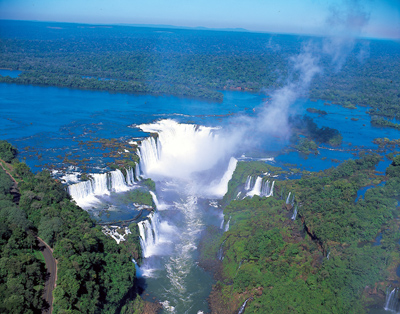
Iguassu Falls - a natural wonder
Iguassu Falls is a world famous destination and
one of the great Wonders of Brazil, wedged at the border of Brazil,
Argentina and Paraguay. There are actually 275 separate waterfalls
that spread out over a 3 km area, some of them over 80 m (260 feet)
high. Sean mentioned that from the Brazilian side you have a wonderful
panoramic view of the falls, while on the Argentinian side there
are hundreds of little trails and walkways that let you get up close
to the falls. You can even take a boat trip (reminiscent of the
"Maid of the Mist" in Niagara Falls) that brings you face
to face with the masses of water thundering down the precipice.
The fauna in this area is also unique, Sean told us about a mischievous
animal called "Coati" that looks a bit like a raccoon
and has a similar penchant for steeling food and playing other tricks
on the visitors.
The Pantanal is an extensive wetland area full
of interesting wildlife. Tour travellers ride on big trucks over
dirt roads and sleep in hammocks. The local fauna includes caymans
(an alligator species), giant armadillos, anteaters and a variety
of rare birds. Sean even showed us a photo of a travel group fishing
for piranhas, he said that's okay "as long as you are not bleeding".
I guess once piranhas taste blood they go into attack mode.
Northern Brazil is a different place altogether:
we saw photos of huge sand dunes and Sean mentioned that the culture
is very different from Rio de Janeiro's. The major city in the area
is Salvador, and its culture, music and cuisine
have a strong East African influence.
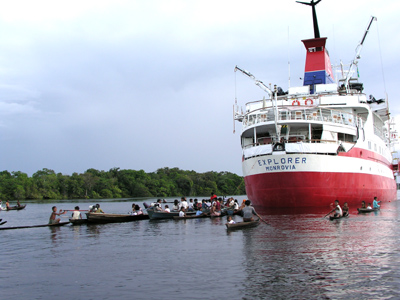
Local residents check out the Explorer
From there you can head west along the Amazon River
on the Explorer Cruise Ship. What makes the Explorer
unique is its shallow draft, so it is able to navigate the Amazon
and can even pull up to some local piers. We saw pictures of tiny
fishing villages and on many photos the natives come right up to
the cruise ship and interact with the travellers. Sean mentioned
that the local residents love connecting with the foreigners, and
usually they will approach the travellers and invite them to a game
of soccer. Zodiacs take you off the cruise ship and right into the
Amazon tributaries where you have to use a machete to hack your
way through the jungle. These are places where no one else can go.
And while the travellers are exploring the local villages, the zodiac
driver takes the local kids for a ride on the boat. (To win a trip
on this famous expedition ship, check out our Travel
Story Contest section...).
Near Manaus, a major port city, the black waters
of the Amazon tributaries meets the brown waters of the Amazon,
and this area is called the "Wedding of the Waters. Manaus
itself has a beautiful opera house which was built by rubber barons.
Manaus was one of the richest cities when rubber was one of the
main export products from Latin America.
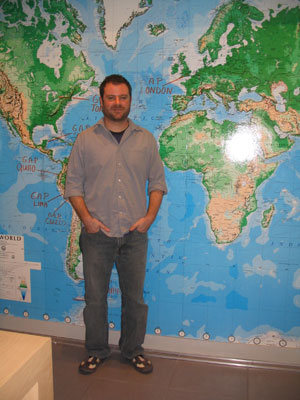
Jeff Russell told us about the tall ship adventure off the Brazilian
Coast
Then Jeff took over and filled us in on his Tall
Ship Sailing Adventure, which took him from Rio de Janeiro to
the port city of Paraty. The actual distance is covered is only
a couple of hundred kilometers, which stretches into a beautiful
7 day adventure on board of the Tocorimé Tall Ship.
G.A.P travellers often say that the transportation element of the
trip is an important experience in itself and this is definitely
the case here. The Tocorimé is the brainchild
of a young man name Marcus who's originally from Calgary. He had
gone sailing on a French ship, loved the experience and decided
to build his own boat. He's an interesting individual himself in
that he now lives in Rio de Janeiro and donates his time to the
community to work with local street kids. He also teaches street
children how to sail for free.
Marcus spent 4 years raising funds, researching old Portuguese
galleons and decided he would build one of these historic ships
with hand tools, without electricity and using wood that was hand
selected from Brazilian forests with the least amount of ecological
impact. He did not use any old growth trees, and the logging itself
that would otherwise have taken a few days actually ended up taking
almost a year.
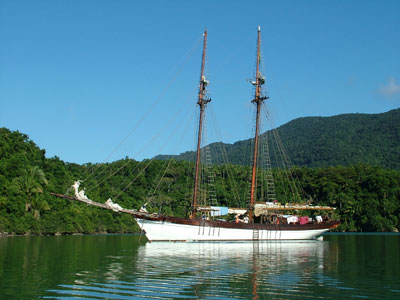
The Tocorimé
Although the Tocorimé was built according to historic plans,
it is a thoroughly modern ship and is equipped with state-of-the-art
radar and GPS systems. The crew will even show you how to plot the
course. The accommodation for travellers are berths on two levels
which are quite comfortable. Sleeping bags are not needed since
the weather is quite warm. Sometimes passengers even choose to sleep
in hammocks on deck, right under the stars.
Jeff also gave us some advice on how to prevent seasickness. He
uses anti-nausea medicated patches that get placed behind the ear
and said that they work like a charm for him. He usually only uses
one third of the full size of the patch which gives him enough anti-nausea
protection without putting him to sleep. Nausea is generally not
a large problem since the ship does not sail on open water.
The ship has two shared bathrooms with built in showers. Much of
the personal cleaning actually happens when travellers swim in the
local waters. G.A.P provides biodegradable soap, so you can even
save time by combining your snorkelling adventure with your personal
hygiene routine.
Originally the Torocimé was anchored in Rio Harbour and
hosted a number of corporate functions and evening sunset cruises.
Mercedes Benz threw one of those parties, and they loved the ship
so much that they donated a Mercedes engine to the Tocorimé.
On any of the tall sailing adventures, the Tocorimé spends
about 50% sailing with the motor, and 50% of the time it is propelled
by the sails alone. Some of the passengers love to climb up the
100 foot mast and dive into the waters of the Atlantic right from
there.
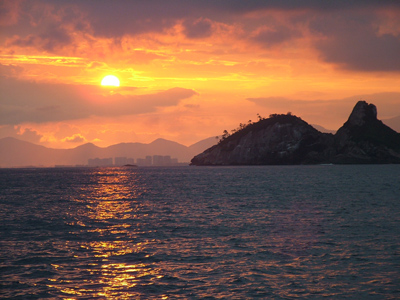
Can you find a better place for a sunset than Rio de Janeiro?
Jeff's adventure on the Tocorimé began in Marina
del Gloria, one of the urban districts within Rio de Janeiro
that is just minutes away from the beaches of Ipanema and Copacabana.
Sugarloaf Mountain and Corcovado are just five minutes away. After
a day of frolicking on the beautiful beaches of Rio, Jeff started
his sailing adventure the next day with a safety briefing and instructions
on how sailing works.
The Tocorimé passengers are actually invited to participate
in the running of the ship. Now this is optional, they don't have
to, but most do because it's such a special experience to help out
on a tall ship. Jeff himself was on watch during one of the nights
between 2 and 6 am and he even helped steer the steer the ship with
the oversize steering wheel (I'm not sure if that's proper sailing
terminology..).
The first day is spent sailing along the coastline in front of
Rio de Janeiro. Jeff referred to it as the "Chile of Cities"
because the city is so long and narrow. Rio has a wonderful coastline
and the photos illustrated how beautiful it must be to see this
world-renowned panorama from a tall ship.
The next morning Jeff woke up in an area called the Mamangua
Fjord that is actually a nature reserve, a total contrast
to the urban panorama of Rio the day before. This area is not serviced
by any roads, there is no electricity, there are no telephones.
The Mamangua Fjord is one of only a few tropical fjords in the world.
It is surrounded by Atlantic Rainforest and its waters are crystal
clear and emerald green.
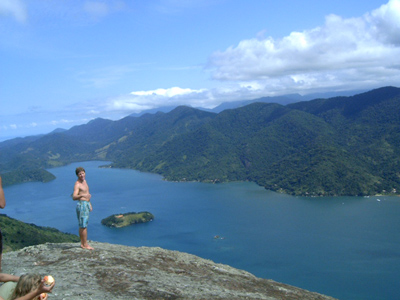
After the hike, a beautiful view overlooking Mamangua Fjord
Jeff mentioned a story where at the end of Mamangua Fjord he went
on shore, picked a bunch of fresh bananas, swam back with them to
the boat and cooked up a fabulous breakfast with the freshly picked
fruit. A little dinghy will get you out into the surrounding fishing
villages where you can hang out with the locals. Or you can hop
into the crystal clear water and just relax supported by a pool
noodle in 85 degree waters.
Paraty is another stop on the trip and as mentioned
earlier, it's a beautiful colonial city with white sandy beaches.
It was founded in the 1500s and celebrated its heyday during the
1700s when Brazil experienced its "Golden Century". Gold
was mined in the surrounding areas and Paraty was the main port
town through which this precious metal was transported back to Portugal.
At some point Paraty had 16,000 inhabitants, but it fell into decline
and by 1954 only 500 people were living there. During the 1970s
roads were finally built to Paraty and tourist started to arrive
to visit this well-preserved city. It has now also been designated
as a UNESO World Heritage Site and today remains a major port for
exporting sugar. Paraty also hosts several Cachaça refineries
where sugar cane is refined into liquor.

Street scene in Paraty
Then, the next day you wake up and find yourself in a totally different
environment around Ilha Grande. Snorkelling is
quite good in this area and although there is no coral you see lots
of tropical fish in the clear coastal waters. This picturesque area
offers hiking, snorkelling, waterfalls or simply some relaxing lounging
in beautiful surroundings. Many of the dinners on this Tall
Ship Adventure are actually held outside on deserted beaches,
where a simple barbecue is built and the travellers enjoy a freshly-cooked
meal, followed by some live bossanova sounds with drums and guitars.
One of the special experiences on Ilha Grande is that dolphins
come right up to the ship and some travellers climb down the anchor
and touch them. Porpoises can also be seen swimming in the distance,
doing backflips, and the more noise you make, the better performance
they will give you.
The food on the Tocorimé is an experience itself, the cook,
a Brazilian lady who doesn't speak a word of English whips up delicious
meals with fresh fish, chicken, steaks, lots of vegetables, salads
made of exotic vegetables like palm hearts and tasty fresh fruits.
Some of the specialties include fish and seafood curries, but even
vegetarians will always have a great variety of delicacies to choose
from.
Jeff and Sean wrapped up their colourful presentation and made
themselves available to questions from the crowd. The audience members
asked about other Latin American trips, other G.A.P sailing adventures
and trips that offer a high level of physical activity. Three G.A.P
staff were on hand to answer all their questions.
My main question remains - with all these wonderful trips to choose
from, which one do you pick?
Related Articles:
More advice from the G.A.P store: how to select the proper
travel gear
G.A.P Adventures
is Canada's largest adventure travel company and a leader in socially
and environmentally sensitive travel. G.A.P is also the sponsor
of the grand prize for our first story contest: an exciting adventure
cruise on the Amazon on the historic and unique Explorer expedition
cruise ship. Visit our contest page to find out more about our
first travel story contest.
|